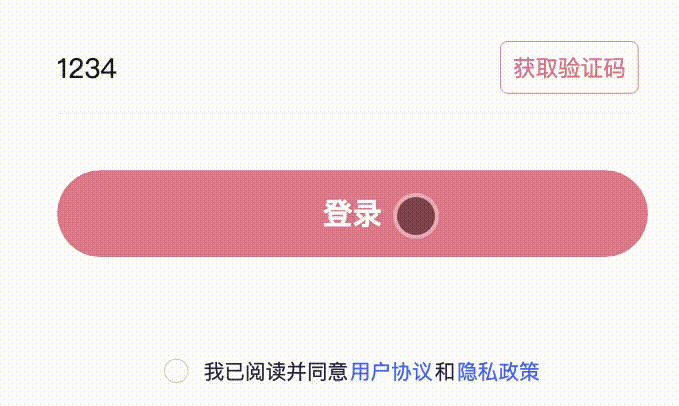社区精选|uniapp 定义动画几种方式
今天小编为大家带来的是社区作者 脑子没墨水 的文章,让我们一起来学习uniapp 定义动画几种方式。
本章的前提就是大家都知道动画的基本属性,例如
animation-name、animation-duration、animation-timing-function、animation-delay、animation-iteration-count和animation-direction 属性。
了解更多 animation 相关的内容。https://link.segmentfault.com/?enc=l4wG0DBt7yotEcCdX9mh6A%3D%3D.cpyym%2FM%2BCWXOET7Oi5fAMM1BT1BrlqtxuB%2FFD0AfJHa6LtJQVQ%2Ftc9P53qB05rNCFAyog%2FJe32GxJkhHQCINsw%3D%3D
现在制作一个左右抖动的动画效果,效果如下:

在 uniapp 中,可以通过如下两种方式来完成。
1. 直接使用 CSS 动画
1.1 定义动画
@keyframes shakeX {
from,
to {
transform: translate3d(0, 0, 0);
}
10%,
30%,
50%,
70%,
90% {
transform: translate3d(-10px, 0, 0);
}
20%,
40%,
60%,
80% {
transform: translate3d(10px, 0, 0);
}
}
.shakeX {
animation-name: shakeX;
animation-duration: 1s;
}
1.2 使用
<view class="box shakeX"></view>
<style>
.box {
width: 100rpx;
height: 100rpx;
background-color: green;
}
</style>
效果如下:

2. 通过 uniapp 提供编程式创建动画
uniapp 提供 createAnimation 内置函数,用于创建一个动画实例 animation。https://link.segmentfault.com/?enc=BLOyXXUmDxIR1QgFDB4pOQ%3D%3D.mh%2FJVljUxHSFeMW0lV9LJfJSvXvK4RyCPMFQVfmSzCQIlXIDW4GzByJGqyEQgktxc%2BR9IsVrQ2a1NR44yI6%2Byg%3D%3D
动画定义步骤:
创建动画实例
调用实例的方法来描述动画
通过动画实例的 export 方法导出动画数据
导出的动画数据传递给组件的 animation 属性(uniapp 提供组件都支持 animation 属性)
兼容性列表:
App | H5 | 微信小程序 | 支付宝小程序 | 百度小程序 | 字节跳动小程序、飞书小程序 | QQ小程序 | 快手小程序 | 京东小程序 |
✓ | HBuilderX 2.0.4+ | ✓ | ✓ | ✓ | ✓ | ✓ | x | x |
注意⚠️:
export方法每次调用后会清掉之前的动画操作。
nvue 暂不支持
2.1 定义动画
接下来通过编程实现上面抖动功能。
2.1.1 创建动画实例
const animation = uni.createAnimation(); // 定义动画实例
2.1.2 调用实例方法来描述动画
在上面的 shakeX 动画定义中,通过 translate3d 来定义动画。对应的在 animation 实例中去查找与 translate3d 相关的实例方法。
translate 相关的实例方法,如下:
方法 | 参数 | 说明 |
translate | tx,[ty] | 一个参数时,表示在X轴偏移tx,单位px;两个参数时,表示在X轴偏移tx,在Y轴偏移ty,单位px。 |
translateX | tx | 在X轴偏移tx,单位px |
translateY | ty | 在Y轴偏移ty,单位px |
translateZ | tz | 在Z轴偏移tz,单位px |
translate3d | (tx,ty,tz) | 在X轴偏移tx,在Y轴偏移ty,在Z轴偏移tz,单位px |
有了这些方法之后,我们可以描述动画啦~
@keyframes shakeX {
from,
to {
transform: translate3d(0, 0, 0);
}
10%,
30%,
50%,
70%,
90% {
transform: translate3d(-10px, 0, 0);
}
20%,
40%,
60%,
80% {
transform: translate3d(10px, 0, 0);
}
}
上面 CSS 中 translate3d,对应到编程方式如下:
animation.translate3d(0, 0, 0); // 原始位置
animation.translate3d(-10, 0, 0); // 向左偏移
animation.translate3d(10, 0, 0); // 像右偏移
有上面方法后,可以把动画描述出来,如下:
animation.animation3d(0, 0, 0) // 0%
.animation3d(-10, 0, 0) // 10%
.animation3d(10, 0, 0) // 20%
.animation3d(-10, 0, 0) // 30%
// ...
.animation3d(0, 0, 0); // 100%
现在通过 export() 方法导出定义动画:
<template>
<view class="box" :animation="animationData"></view>
</template>
export default {
data() {
return {
animationData: {}
}
},
onLoad(){
const animation = uni.createAnimation();
animation.animation3d(0, 0, 0) // 0%
.animation3d(-10, 0, 0) // 10%
.animation3d(10, 0, 0) // 20%
.animation3d(-10, 0, 0) // 30%
// ...
.animation3d(0, 0, 0); // 100%
this.animationData = animation.export();
}
}
代码运行之后,并没有如期出现预期抖动效果。为什么?因为 uniapp 中在定义的一组动画中是并行执行的,所以并不会产生动画效果。
再回过来,看上面 CSS 中把一个动画周期划分成不同的组(步骤),10% 时执行 translate3d(-10px, 0, 0),20% 时执行translate3d(10px, 0, 0)。
在 uni-app 中有没有类似的方式呢?通过 step 来定义。
animation
.translateX(0) // 0%
.translateX(10) // 20%
.step();
animation.translateX(-10).step(); // 30%
animation.translateX(10).step(); // 40%
animation.translateX(-10).step(); // 50%
animation.translateX(10).step(); // 60%
animation.translateX(-10).step(); // 70%
animation.translateX(10).step(); // 80%
animation.translateX(-10).step(); // 90%
animation.translateX(0).step(); // 100%
this.animationData = animation.export();
再来执行代码,发现会动了。

从效果来看发现跟预期效果差很多,为什么? 跟 animation 的 animation-duration 属性有关。
animation-duration: 属性指定一个动画周期的时长。
也就是一组动画运行完所需时间。在 uni.createAnimation() 创建动画时可以传递参数,在不显示的指定 duration 值时,默认值为 400ms。而 step() 会继承该值。
参数 | 类型 | 必填 | 默认值 | 说明 |
duration | Integer | 否 | 400 | 动画持续时间,单位ms |
timingFunction | String | 否 | "linear" | 定义动画的效果 |
delay | Integer | 否 | 0 | 动画延迟时间,单位 ms |
transformOrigin | String | 否 | "50% 50% 0" | 设置transform-origin |
这就是 “慢” 的原因。
在明白“慢”之后,只要把动画执行时间 (duration) 调整,应该能看到预期效果。假设期望完成抖动时间 1s,把动画拆分成 10 组,则每一组的动画时间为 100 ms.
现在指定 step 的 duration 值为 100ms,更改后代码如下:
animation
.translateX(0) // 0%
.translateX(10) // 20%
.step({
duration: 100,
});
animation.translateX(-10).step({
duration: 100,
}); // 30%
animation.translateX(10).step({
duration: 100,
}); // 40%
animation.translateX(-10).step({
duration: 100,
});
// 50%
animation.translateX(10).step({
duration: 100,
}); // 60%
animation.translateX(-10).step({
duration: 100,
}); // 70%
animation.translateX(10).step({
duration: 100,
}); // 80%
animation.translateX(-10).step({
duration: 100,
}); // 90%
animation.translateX(0).step({
duration: 100,
});
this.animationData = animation.export();
再来执行代码,运行效果如下:

发现效果基本与预期效果一样了。
更多 uni.createAnimation() 相关的内容,可以自行查看文档
3. 什么情况下使用编程式创建动画
当不能通过 css 方式或通过动态类名一些方式去添加动画时,此时就可以考虑使用编程式来创建动画。编程式可以很灵活创建动画、控制动画运行和监听动画的结束。其次从兼容列表来看,能很好在同平台运行。
现在看个实际例子: 在登录时,通常需要 ☑️ 选用户协议和隐私政策 之后才允许用户登录。现在产品希望当用户在未勾选时点击登录,希望通过抖动 用户协议和隐私政策来提醒用户。

上面需求需要完成几个功能点:
定义抖动动画类
未勾选时动态添加动画类
动画结束时移除动画类(用户下一次点击时,需要继续抖动)
通常可以这样做:
<view ref="agreement" class="agreement" :class="{ 'shakeX': actived }">
<radio
@click="onChecked"
style="transform: scale(0.6)"
:color="color"
:checked="agreement"
></radio>
我已阅读并同意<text class="service"
>用户协议</text
>和<text class="privacy">隐私政策</text>
</view>
<button @click="onLogin">登录</button
export default {
data() {
return {
actived: false // false
};
},
mounted(){
this.$refs.agreement.$el.addEventListener("animationend", ()=> {
this.actived = false; // 动画结束移除类
});
},
methods: {
onLogin(){
// 动态添加
this.actived = true;
}
},
}
@keyframes shakeX {
from,
to {
transform: translate3d(0, 0, 0);
}
10%,
30%,
50%,
70%,
90% {
transform: translate3d(-10px, 0, 0);
}
20%,
40%,
60%,
80% {
transform: translate3d(10px, 0, 0);
}
}
.shakeX {
animation-name: shakeX;
animation-duration: 1s;
}
发现在 app、小程序 上运行时,发现 this.$refs.agreement.$el 为空,这是为什么,这里就是跟 uniapp 底层设计有关,如下图所示:

上面引用微信小程序,uniapp 在设计跟小程序是一样的。也可以在上底层设计链接中了解到 uniapp 设计。
如果不能获取元素并注册animationend事件,没办法很好知道动画结束,不知道何时应该移除。当然有的人想可以通过定时器完成,这样不能精细话控制。
此时通过编程式就可以很好解决兼容的问题,现在稍微调整下:
<view class="agreement" :animation="animationData">
<radio
@click="onChecked"
style="transform: scale(0.6)"
:color="color"
:checked="agreement"
></radio>
我已阅读并同意<text class="service"
>用户协议</text
>和<text class="privacy">隐私政策</text>
</view>
<button @click="onLogin">登录</button>export default {
data() {
return {
animationData: {}
};
},
onLoad(){
const animation = uni.createAnimation({
timingFunction: "linear",
});
this.animation = animation;
},
methods: {
shakeX() {
const animation = this.animation;
animation
.translateX(0) // 0%
.translateX(10) // 20%
.step({
duration: 100,
});
animation.translateX(-10).step({
duration: 100,
}); // 30%
animation.translateX(10).step({
duration: 100,
}); // 40%
animation.translateX(-10).step({
duration: 100,
});
// 50%
animation.translateX(10).step({
duration: 100,
}); // 60%
animation.translateX(-10).step({
duration: 100,
}); // 70%
animation.translateX(10).step({
duration: 100,
}); // 80%
animation.translateX(-10).step({
duration: 100,
}); // 90%
animation.translateX(0).step({
duration: 100,
});
this.animationData = animation.export();
},
onLogin(){
this.shakeX();
}
},
};
通过编程方式,为什么不需要像动态类名的方式,动画结束必须移除类名否则下次不会生效? 这里留给大家去思考了。
4. 总结
具体采用哪种方式创建动画,可以根据实际业务场景来定。
uniapp 编程方式,通过 step 来进行动画分组,同一个分组内动画函数会并行执行。
多个动画分组之间的执行是串行的,也就是需等待上一个结束才会执行下一个。


关注公众号:拾黑(shiheibook)了解更多
赞助链接:
关注数据与安全,洞悉企业级服务市场:https://www.ijiandao.com/
四季很好,只要有你,文娱排行榜:https://www.yaopaiming.com/
让资讯触达的更精准有趣:https://www.0xu.cn/
 关注网络尖刀微信公众号
关注网络尖刀微信公众号随时掌握互联网精彩
- BuildAdmin:一键生成代码省3周开发时间,开箱即用爽到飞起!
- Lsky-pro 用于在线上传、管理图片的图床程序
- 美国要让谷歌分拆 出售安卓等资产:谁会接盘 国产厂商有机会吗
- 美元兑人民币汇率2024年1月29日
- 欧元人民币汇率2023年12月24日
- Dynamics 365 Field Service:为每位一线员工配备随身智能助手
- 或许尚未尘埃落定,OpenAI宫斗戏仍在变化中
- 谁“杀死”了《谭谈交通》
- 千兆光网被写入政府工作报告:F5G全光城市迎来发展新纪元
- 春节就是要嗨起来 提升节日气氛的好物推荐
- 刷爆技术圈的《知识图谱》终于补货了,最后 968 份,低至 2 折,抢完不补!
- Linux 能否拿下苹果 M1 阵地?








 微信扫码关注公众号
微信扫码关注公众号